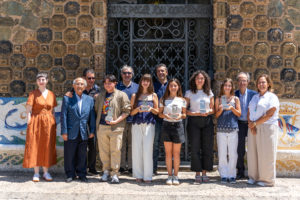October 6, 2022
Gaudí, emblem of Barcelona
When we think of Barcelona, the beauty of its buildings and architecture, the word Gaudí will inevitably come to mind, since this architect and the city of Barcelona are inextricably linked.
Antoni Gaudí, born in Reus on June 25, 1852, was the greatest representative of architectural modernism and a pioneer in the most avant-garde artistic movements. He suffered during his childhood from rheumatic problems that prevented him from going to school or playing with other children, so from an early age, he developed a special sense for the observation of nature, its color and all its forms.
This is how his interest in architecture and drawing grew until he became a result in his moving to Barcelona and entering the School of Architecture at the age of seventeen.
In 1878, he obtained his degree in architecture and would begin his work with the patronage that the new bourgeoisie of Barcelona would grant him. It is important to recognize that the city was at a time of economic and cultural flourishing that undoubtedly favored the search for new architectural styles and experimentation, as well as the construction of all kinds of buildings, from cultural to industrial, which would be overshadowed by modernism (art nouveau), an artistic trend that would become dominant at the end of the 19th century and the beginning of the 20th.
From here he would develop, throughout his career as an architect, different techniques and styles that would make him a unique and inspiring reference for the architects who came after.
His footprint and legacy in Barcelona have undoubtedly made his works a symbol of the city and a tourist attraction, with seven of them also considered World Heritage by UNESCO. It is because of this that, among the many things that can be done when visiting Barcelona, the modernist route stands out: an itinerary through which you can visit numerous unique buildings, where Gaudí ‘s work stands out, and it is a benchmark in the world of art and architecture.
Revolutionizing architecture: general characteristics of Gaudí’s technique
From his time until today, Gaudí’s work has been admired and recognized by architects all over the world because of his distinctive and unique style. And it is that right from the beginning, Gaudí’s designs showed their own and avant-garde identity that converged in what we would know as the modernist movement.
As we know, Gaudí spent a childhood and adolescence characterized by the observation of nature and attention to its details, and he would later transfer this to his buildings, in which it is easily observable if we look at the abundance of organic, geometric shapes and in the use of curves, as well as stone and color.
Another characteristic element of Gaudí’s style, which we often find in his works, is that of the medieval Gothic style, derived from the influence of the “Renaixença” which claimed its own culture on the basis of nationalist sentiment. In this way, in Gaudí’s work it is common to find elements of medieval Gothic and Mudéjar-style inspiration combined, thus seeking to symbolize the historical identity integrated into modernist architecture.
Gaudí’s architectural style also stands out for the integration of ornament in his buildings, plant forms and whimsical decorative elements that are part of the very essence of architectural modernism and of which Gaudí would be a pioneer. Among his designs we find furniture and decorative elements in various materials such as ceramics, glass and even wrought iron.
Light and color were of primary importance, and he reflected this in his designs, while taking into account the functionality that the building was going to fulfill when designing it: his technique was not solely focused to cover a certain aesthetic style or a simple fashion of its time, but sought to endow the construction with characteristics that facilitated the function it aimed to fulfill, and we can appreciate this both in the general distribution and in the plan of its buildings
We must not fall into the mistake of considering Antoni Gaudí as a simple modernist architect, but understand that his style, although it contributed to modernism, has its own character that makes it unique. Today, he is recognized as a differentiating architect, revolutionary and separate from modernism, for the characteristics he brings together and which make him unique.
Gaudí’s characteristic styles
Gaudí’s style has been studied by numerous art historians, who have tried to divide and classify his prodigious work. Currently, it is considered the best way to analyze Gaudí’s technique that was established by the architect and essay there is Joan Bergós i Massó, who meticulously studied Gaudí’s work in order to organize it into different stages. These stages are based on the different techniques and styles that the famous architect used, and not on a chronological order of specific time periods.
According to this classification, we can divide Gaudí’s work into five different styles that characterized it, namely: preliminary period, Mudéjar-Moorish, evolved Gothic, expressionist naturalism and organic synthesis.
Preliminary period
It is the moment in which Gaudí’s architectural career began, including his last years of career and his first professional work after obtaining his degree in architecture.
Elements from this period can be highlighted, such as the Lanterns of Plaça Real, which are considered a Cultural Asset of Local Interest in the Catalan Cultural Heritage Inventory.
In the same way, he carried out numerous collaborations, such as the monumental fountain in the Ciutadella Park with the master Fontserè or the Salesas convent in Barcelona with the architect Martorell.
Mudéjar-Moorish
These are constructions that are identified by the geometric polychromy that characterizes them, that is to say, where the contrast between brick and ceramic, as well as between their colors, is accentuated. Added to this are elements inspired by medieval Mudéjar art, such as domes.
In this style, the most outstanding building is that of Casa Vicens, in Barcelona, in which you can appreciate the disparity of colors creating a strong counterpoint, as well as the Moorish elements of Arab inspiration.
Other works worth mentioning that fall within this stage are the Palau Güell in Barcelona or El Capricho de Gaudí in Cantabria.
Evolved Gothic
Gaudí considered the Gothic style as an imperfect, unstable and poorly structured art, according to which he defined it as “a defective body that holds itself up with crutches”.
Despite this consideration regarding Gothic art, Gaudí studied this style deeply and ended up designing different neo-Gothic style buildings, in a free manner, but inspired by the original Gothic aesthetics, which have contributed to creating this technique that makes him an architect different from others.
In fact, many of Gaudí’s most emblematic and visited works fit into this style: visit the Torre Bellesguard Gaudí and you will be able to easily recognize the Gothic and medieval influences, imitating the turrets of castles and with mainly brown colors.
Expressionist naturalism
In this case, the main inspiration came from the baroque and ended up evolving through vitalist modernism. At this stage, the most obvious Gothic and medieval characteristics are abandoned, but the overloaded decoration remains, and the color contrasts are noticeably accentuated.
The facades become much more expressive, this can be seen in buildings such as Casa Calvet, Parc Güell, Casa Batlló or Casa Milà.
Organic synthesis
This is the last stage of Gaudí’s characteristic style, where he achieves a level of expressiveness, curved shapes and almost perfect plasticity.
To this period belongs his best-known work, which no one should miss if they are in Barcelona: the Temple of the Sagrada Família. With this great architectural work, a symbol of an entire imposing city, Gaudí, who was a man of religious convictions, sought to give maximum expression to his beliefs.
With the Temple of the Sagrada Família, all the elements of the previous stages come together in one: neo-Gothic inspired components such as the towers, baroque decoration, shapes inspired by nature stand out…
If you enjoy art, architecture, good gastronomy and beauty, there is no better way to combine all this than by following the modernist route in Barcelona, visiting such emblematic buildings as the Sagrada Família or la Torre Bellesguard.
Gaudí has left an indelible mark and a display of his talent in every corner of Barcelona, as well as in other parts of Catalonia and Spain. Getting to know these buildings doesn’t just mean immersing yourself in art and architecture, it also means witnessing the work of one of humanity’s most distinguished architects and a piece of the history of the city of Barcelona.




